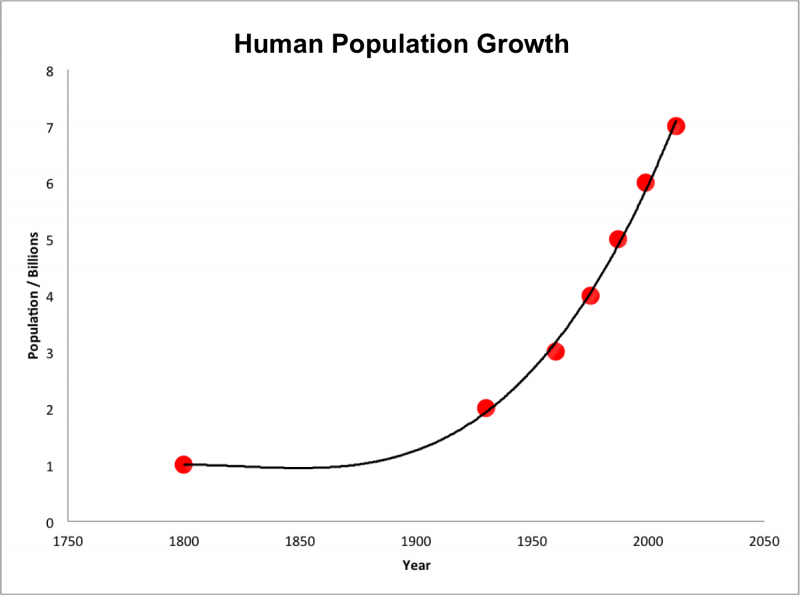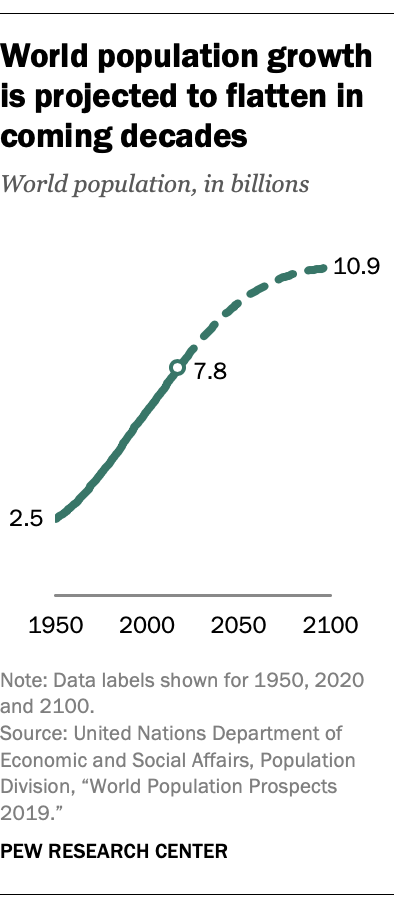

Human population growth from 1800 to 2000, via Wikimedia Commons.
October 12, 1999. The United Nations Population Fund (UNFPA), marked this date as the Day of 6 Billion. That’s because – on October 12, 1999 – the world’s human population was estimated to hit 6 billion, according to the United Nations. It took hundreds of thousands of years for Earth’s human population to reach 1 billion in 1804. The 3 billion milestone came in 1960. Not quite 40 years later, global population had doubled to 6 billion.
In 2011, global population reached 7 billion mark. Today – October 12, 2019 – it stands at more than 7.7 billion.
Population experts did not agree on the exact date that world population reached the six billion milestone, of course, but they came close. For example, the U.S. Census Bureau set the date just a few months earlier, to June 18 or June 19, 1999. These numbers are estimates, after all.
Human population is still growing, and, in fact, it’s growing slightly faster than experts a few years ago thought it would. Driven by growth in developing countries, population is now expected to reach around 8.5 billion in 2030, 9.7 billion in 2050, and 10.9 billion in 2100. These numbers represent a mid-range. Some projections are higher, or lower.
These estimates come from the UN report World Population Prospects 2019.
According to a June 17, 2019 article by the Pew Research Center, Earth’s human population growth is projected to nearly stop growing by the end of this century. The article explains:
For the first time in modern history, the world’s population is expected to virtually stop growing by the end of this century, due in large part to falling global fertility rates, according to a Pew Research Center analysis of new data from the United Nations.
By 2100, the world’s population is projected to reach approximately 10.9 billion, with annual growth of less than 0.1% – a steep decline from the current rate. Between 1950 and today, the world’s population grew between 1% and 2% each year, with the number of people rising from 2.5 billion to more than 7.7 billion.
Pew has also provided 11 key takeaways from the UN’s World Population Prospects 2019. We list the highlights here. Go to Pew’s page to read more about each of the takeaways listed here:
1. Global fertility is falling as the world is agingThe global fertility rate is expected to be 1.9 births per woman by 2100, down from 2.5 today.
2. The world’s median age is expected to increase to 42 in 2100, up from the current 31 – and from 24 in 1950.
3. Africa is the only world region projected to have strong population growth for the rest of this century.
4. Europe and Latin America are both expected to have declining populations by 2100.
5. The population of Asia is expected to increase from 4.6 billion in 2020 to 5.3 billion in 2055, then start to decline.
6. In the Northern America region, migration from the rest of the world is expected to be the primary driver of continued population growth.
7. By 2100, five of the world’s 10 largest countries are projected to be in AfricaSix countries are projected to account for more than half of the world’s population growth through the end of this century, and five are in Africa.
8. India is projected to surpass China as the world’s most populous country by 2027.
9. Between 2020 and 2100, 90 countries are expected to lose population.
10. Africa is projected to overtake Asia in births by 2060.
11. The Latin America and Caribbean region is expected to have the oldest population of any world region by 2100, a reversal from the 20th century.

Via Pew Research Center.
Bottom line: On October 12, 1999, global human population was estimated to hit 6 billion, according to the United Nations. UNFPA, aka the United Nations Population Fund, marked this date as the Day of 6 Billion.
from EarthSky https://ift.tt/2MbgrIY


Human population growth from 1800 to 2000, via Wikimedia Commons.
October 12, 1999. The United Nations Population Fund (UNFPA), marked this date as the Day of 6 Billion. That’s because – on October 12, 1999 – the world’s human population was estimated to hit 6 billion, according to the United Nations. It took hundreds of thousands of years for Earth’s human population to reach 1 billion in 1804. The 3 billion milestone came in 1960. Not quite 40 years later, global population had doubled to 6 billion.
In 2011, global population reached 7 billion mark. Today – October 12, 2019 – it stands at more than 7.7 billion.
Population experts did not agree on the exact date that world population reached the six billion milestone, of course, but they came close. For example, the U.S. Census Bureau set the date just a few months earlier, to June 18 or June 19, 1999. These numbers are estimates, after all.
Human population is still growing, and, in fact, it’s growing slightly faster than experts a few years ago thought it would. Driven by growth in developing countries, population is now expected to reach around 8.5 billion in 2030, 9.7 billion in 2050, and 10.9 billion in 2100. These numbers represent a mid-range. Some projections are higher, or lower.
These estimates come from the UN report World Population Prospects 2019.
According to a June 17, 2019 article by the Pew Research Center, Earth’s human population growth is projected to nearly stop growing by the end of this century. The article explains:
For the first time in modern history, the world’s population is expected to virtually stop growing by the end of this century, due in large part to falling global fertility rates, according to a Pew Research Center analysis of new data from the United Nations.
By 2100, the world’s population is projected to reach approximately 10.9 billion, with annual growth of less than 0.1% – a steep decline from the current rate. Between 1950 and today, the world’s population grew between 1% and 2% each year, with the number of people rising from 2.5 billion to more than 7.7 billion.
Pew has also provided 11 key takeaways from the UN’s World Population Prospects 2019. We list the highlights here. Go to Pew’s page to read more about each of the takeaways listed here:
1. Global fertility is falling as the world is agingThe global fertility rate is expected to be 1.9 births per woman by 2100, down from 2.5 today.
2. The world’s median age is expected to increase to 42 in 2100, up from the current 31 – and from 24 in 1950.
3. Africa is the only world region projected to have strong population growth for the rest of this century.
4. Europe and Latin America are both expected to have declining populations by 2100.
5. The population of Asia is expected to increase from 4.6 billion in 2020 to 5.3 billion in 2055, then start to decline.
6. In the Northern America region, migration from the rest of the world is expected to be the primary driver of continued population growth.
7. By 2100, five of the world’s 10 largest countries are projected to be in AfricaSix countries are projected to account for more than half of the world’s population growth through the end of this century, and five are in Africa.
8. India is projected to surpass China as the world’s most populous country by 2027.
9. Between 2020 and 2100, 90 countries are expected to lose population.
10. Africa is projected to overtake Asia in births by 2060.
11. The Latin America and Caribbean region is expected to have the oldest population of any world region by 2100, a reversal from the 20th century.

Via Pew Research Center.
Bottom line: On October 12, 1999, global human population was estimated to hit 6 billion, according to the United Nations. UNFPA, aka the United Nations Population Fund, marked this date as the Day of 6 Billion.
from EarthSky https://ift.tt/2MbgrIY


Aucun commentaire:
Enregistrer un commentaire